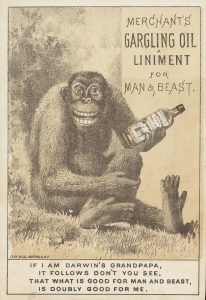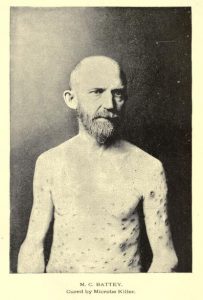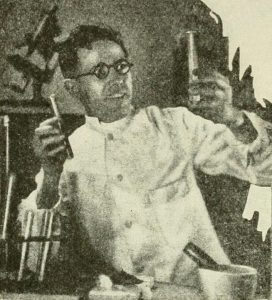Skin

Merchant’s Gargling Oil
ADvent Calendar Day 14 If people evolved from apes, why are apes still selling Gargling Oil? Ask this fellow, taking a break from evading sasquatch hunters to advise punters that Merchant’s liniment is good for both man and beast. It was mainly an external remedy for bruises, wounds, skin diseases, burns etc, but people could […]
Read MoreFor the blood is the life
The Quack Doctor is currently providing Victorian remedies for Sky Living’s online newspaper, The Inquisitor, which accompanies the channel’s new ten-part drama, Dracula. If you are visiting the site for the first time via sky.com, welcome! ‘For the blood is the life’: the evocative quotation appears in the very first scene of Sky Living/NBC’s […]
Read More
An ulcer as big as a hen-egg
Patient testimonials were (and indeed remain) an integral part of the promotion of non-evidence-based health products. While 19th-century newspaper advertising only had room for concise endorsements, promotional books and pamphlets allowed medicine proprietors to give more detailed case studies of those who had supposedly benefited from their products. This one by Mr M C Battey, […]
Read MorePoison. To be applied night and morning.
I have some wonderful pictures to share with you today thanks to collector Rex Barber from Perth, Western Australia, who owns several hundred 18th – 20th century proprietary remedy lids. Rex has exhibited his collection as far afield as the Federation of Historical Bottle Collectors’ 2012 show in Reno, NV. Many lid designs not only […]
Read MoreBailey’s Rubber Complexion Brush
A harmless alternative to the arsenical preparations then in vogue for improving the complexion, Bailey’s rubber brush was intended to improve the circulation, clear the pores and allow the blood to free itself of impurities. Charles J Bailey of Newton, Massachusetts, invented the product in 1887, immediately patenting it in England, France, Canada, Belgium […]
Read More
Terradermalax – a skin laxative
Source: The Pittsburgh Press, 11 March 1923 . . Why, when a woman is 30, do her blushes no longer show? How does a skin grow dull and unlovely while the eyes are still clear and sparkling? Science has learned the reason, and – glorious news! – a painless, pleasant way to correct it in […]
Read MoreLudlam's Electric Rubber
Source: The Medical Directory for Scotland, 1853 (click to enlarge ad or see transcript below.) This product was reviewed by The London Lancet, (vol.1 1851) which heartily endorsed it as a way of creating rapid and healthy circulation of the blood on the surface after bathing. “Rubber” here means something to be used for rubbing, […]
Read MoreAlbert's Grasshopper Ointment
Grasshopper Ointment was registered in 1874 and the name was trademarked in 1884. It was still listed in Martindale’s Extra Pharmacopoeia in 1989, where the ingredients were given as rosin, yellow beeswax, larch oleoresin, arachis oil, white soft paraffin and copper acetate – but no grasshoppers. The copper would have given it a green tint […]
Read MoreSamaritan Water
The proprietor of this remedy, Thomas Greenough, was better known for his other preparation, the Lozenges of Tolu, which were for coughs and colds. The Samaritan Water, patented in 1779, was not widely advertised, but the lozenges continued to be sold by Greenough’s successor at Ludgate Hill, R. Hayward, during the first half of the […]
Read MoreCuticura Soap and Ointment
Skin “literally on fire”? Then you need Cuticura – or possibly a large bucket of water and a good plastic surgeon. Cuticura originated in the US in 1865 and had reached the UK by 1880. The famous company is, of course, still going strong with a wide range of top-quality skincare and haircare products, as […]
Read More